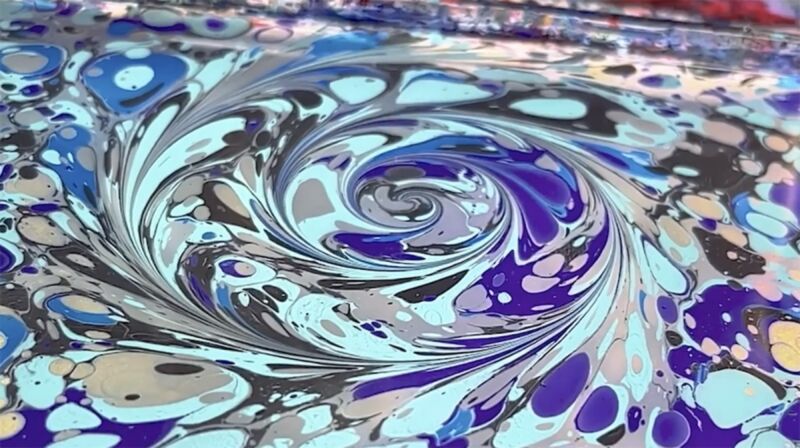
Marbled paper is an art form that dates back at least to the 17th century, when European travelers to the Middle East brought back samples and bound them into albums. Its visually striking patterns arise from the complex hydrodynamics of paint interacting with water, inspiring a winning video entry in this year's Gallery of Fluid Motion.
The American Physical Society's Division of Fluid Dynamics sponsors the gallery each year as part of its annual meeting, featuring videos and posters submitted by scientists from all over the world. The objective is to highlight "the captivating science and often breathtaking beauty of fluid motion" and to "celebrate and appreciate the remarkable fluid dynamics phenomena unveiled by researchers and physicists."
The three videos featured here are the winners of the Milton Van Dyke Awards, which also included three winning posters. There were three additional general video winners—on the atomization of impinging jets, the emergent collective motion of condensate droplets, and the swimming motion of a robotic eel—as well as three poster winners. You can view all the 2023 entries (winning and otherwise) here.
The hydrodynamics of marbling art
Harvard University graduate student Yue Sun was fascinated by the process and the resulting patterns of making marbled paper, particularly the randomness. "You don't really know what you're going to end up with until you have it printed," she told Physics Magazine.
AdvertisementAlthough there are several different methods for marbling paper, the most common involves filling a shallow tray with water, then painstakingly applying different ink or paint colors to the water's surface with an ink brush to cover the surface with concentric circles. Adding surfactants makes the colors float so that they can be stirred—perhaps with a very fine human hair—or fanned out by blowing on the circles of ink or paint with a straw. The final step is to lay paper on top to capture the colorful floating patterns. (Body marbling relies on a similar process, except the floating patterns are transferred onto a person's skin.)
Sun was curious about the hydrodynamics at play and explored two key questions in the simulations for the video. Why does the paint or ink float despite being denser than the liquid bath? And why don't the colors mix together to create new colors when agitated or stirred? The answer to the former is basically "surface tension," while the latter does not occur because the bath is too viscous, so the diffusion of the paint or ink colors across color boundaries happens too slowly for mixing. Sun hopes to further improve her simulations of marbling in hopes of reverse-engineering some of her favorite patterns to determine which tools and movements were used to create them.
Dynamics of frost propagation
How the ice crystals form and grow is a longstanding subject of scientific interest. Frost typically forms on surfaces that are colder than the surrounding air. There is always a certain amount of water vapor in air. Frost forms when that air becomes supersaturated, the excess water vapor is deposited as seed crystals on various surfaces, and the air temperature drops below the dew point. This triggers a phase change directly from gas (water vapor) to ice and ice crystals begin to form.
There are many different kinds of frost: crystalline (hoar) frost, white frost, black frost, advection frost, and the frost that forms on glass windows, to name a few. David Paulovics, a graduate student at Cote d'Azur University in France, worked with colleagues to capture frost forming on a surface coated with liquid condensation (similar to a bathroom mirror fogging up) with an infrared camera. When the temperature was reduced to about minus 20° Celsius, the condensation turned into frost.
They expected supercooled droplets to form, but Paulovics et al. were surprised to find that when those droplets crystallized, they released a burst of heat in the form of infrared light (recalescence). They noticed that the droplets froze in a ring-shaped pattern spreading outward rather than randomly—similar to the spread of a virus. That propagation occurred because of tiny ice bridges that formed, connecting frozen droplets to their nearest liquid neighbors. The model the team developed could enhance our understanding of frost formation on airplane wings, among other potential applications.
AdvertisementLiquid lace
The final Van Dyke video winner is Princeton University graduate student Lauren Drier, who took slow-motion videos of the streams of plastic produced by a 3D printer before solidifying into a straight thread. The speed at which the print head moves is a determining factor in how the final thread forms. For instance, if you over-extrude so that too much material is deposited too slowly, you get coiling instabilities.
If the head moves faster than usual, too little material is deposited too quickly (under-extrusion). The resulting thread doesn't merely get thinner; it begins alternating between sticking and stretching, producing an unusual lacy pattern of holes in the hardened plastic thread. When those threads are layered, it produces a "plastic lace" material that is self-stabilizing.
Drier and her colleagues tested the plastic lace's properties and found that the resulting material was lighter and needed less plastic to cover a given area, as well as behaving more like a textile in terms of its stretchiness. They found they could even "tune" the wavelengths. So it should be possible to use this quirky feature of 3D printers to create periodic holes without the need for molds or machining, perhaps for use in soft robotics or to create shock-absorbing materials. But the lacy pattern is also visually striking—especially when set to Bach's "Violin Sonata No. 2."



















